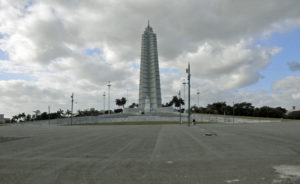
José Martí Memorial in Havana’s Plaza de la Revolución (Photo by Don Knebel)
Between 1925 and 1930, Jean-Claude Nicolas Forestier, a French landscape architect, lived in Havana designing a grand master plan for a new center of the city, with a large public square or plaza at its heart. The Great Depression delayed plans to realize Forestier’s designs, but construction of the plaza began in the 1950s during the government of President Fulgencio Batista. At its center was a 358-foot tall star-shaped memorial to José Martí, a nineteenth century Cuban intellectual who advocated for independence from Spain and was killed in a battle with Spanish forces in 1895, becoming a national hero. When dedicated in 1959, the 18-acre public plaza was called Plaza Civica.
After Castro seized power from Batista in 1959, Cubans gathered in huge numbers on the Plaza Civica to show their support. Two years later, Castro renamed the plaza in honor of his revolution. He spoke to huge crowds gathered on the plaza each May Day and July 26, the anniversary of his unsuccessful attack on a military base in Santiago in 1953 that served as a rallying cry for the revolution. Gray government buildings now surround the plaza, one featuring a large metal outline of the face of Che Guevara and another the face of Camilo Cienfuegos, heroes of Castro’s revolution.
In 1998, John Paul II, the first Pope to visit Cuba, held a large outdoor Mass in the Plaza de la Revolución and Pope Francis held Mass there during his visit in 2015. The Plaza de la Revolución is a must-see on a visit to Havana.